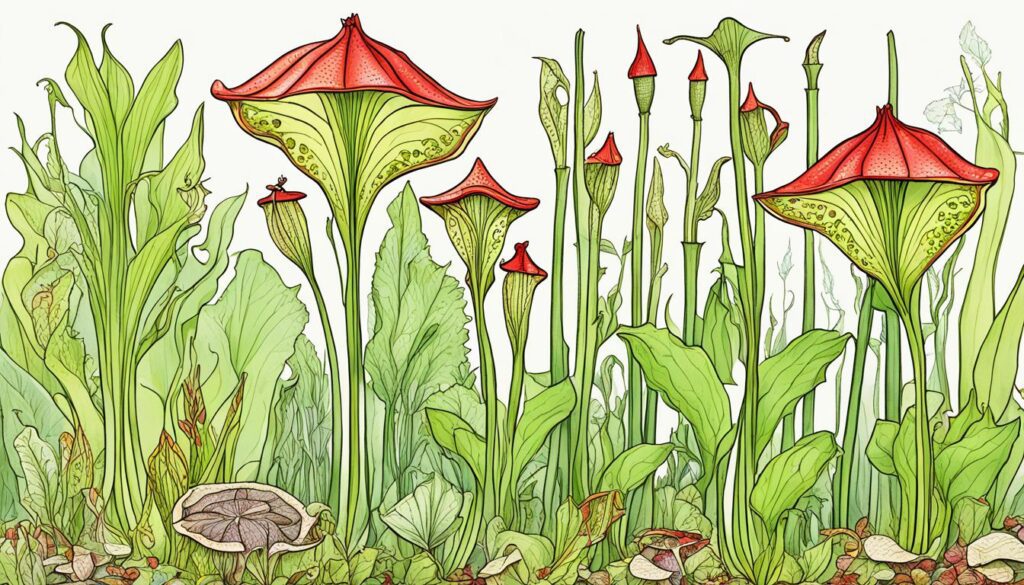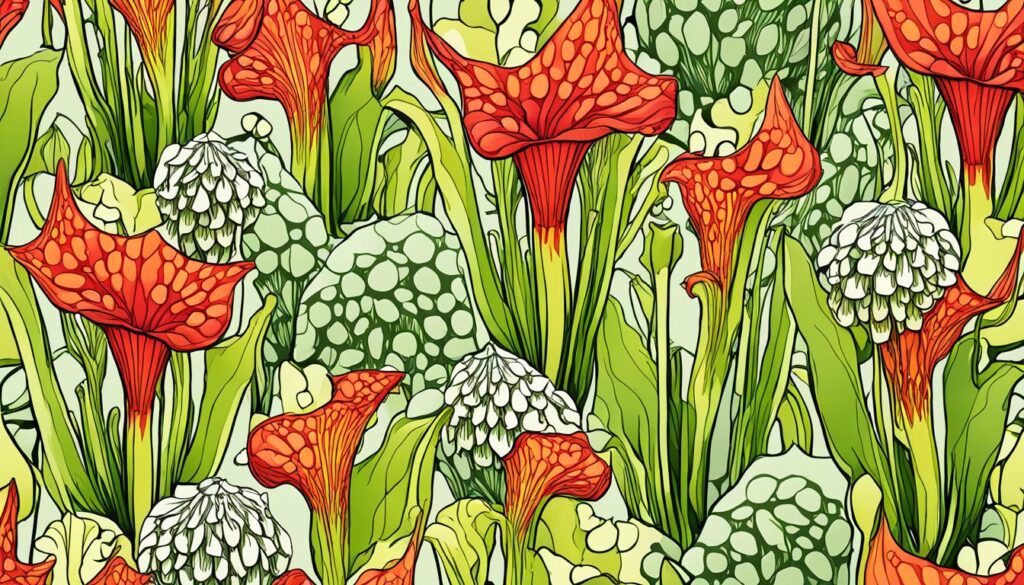O gênero Sarracenia, também conhecido como plantas-jarro, são uma fascinante família de plantas carnívoras nativas da América do Norte. Pertencentes à família Sarraceniaceae, estas flores encontram-se em turfeiras, pântanos e outros ambientes pobres em nutrientes.
As Sarracenia evoluíram adaptações únicas, como folhas modificadas em forma de jarro, para capturar e digerir insetos e outros pequenos animais, desafiando as normas típicas da vida vegetal.
Estas plantas são verdadeiras maravilhas botânicas, exibindo uma diversidade de formas, cores e estratégias de sobrevivência. Desde as imponentes Sarracenia flava às delicadas Sarracenia psittacina, cada espécie apresenta características cativantes que as tornam membros únicos da flora insectívora que povoa os pântanos e bogs da América do Norte.
Introduction to Sarracenia: Nature’s Insect Traps
Sarracenia plants, commonly known as pitcher plants, are captivating members of the carnivorous plant family. These unique flora have evolved a remarkable adaptation that allows them to thrive in nutrient-poor habitats: the transformation of their leaves into pitcher-like structures. These specialized leaves not only attract insects through their vibrant colors and nectar, but also use a combination of slippery surfaces and digestive enzymes to trap and consume their prey.
Captivating Characteristics of Pitcher Plants
The Sarracenia’s iconic pitcher-shaped leaves are a testament to the ingenuity of nature. These structures are designed to lure in unsuspecting insects with their vivid hues and sweet-smelling nectar. Once an insect is attracted and steps inside the pitcher, it encounters a slippery, downward-facing surface that makes it nearly impossible to escape. The plant’s digestive enzymes then break down the insect, providing the Sarracenia with vital nutrients that it would otherwise struggle to obtain in its nutrient-poor wetland or bog habitat.
Sarracenia’s Unique Adaptations for Survival
To thrive in their challenging environments, Sarracenia plants have developed a remarkable array of adaptations. Beyond their pitcher-shaped leaves, these carnivorous plants have evolved specialized features such as digestive enzymes, underwater “traps,” and even specialized modified leaves that can function as lids to prevent the escape of trapped insects. These adaptations allow Sarracenia to supplement their nutrient intake, enabling them to survive and even flourish in the nutrient-deficient habitats they call home.

“The Sarracenia’s remarkable adaptations are a testament to nature’s ingenuity and the plant’s resilience in the face of nutrient-poor environments.”
Sarracenia: A Diverse Marvel of Carnivorous Flora
The Sarracenia genus represents a truly remarkable and diverse array of carnivorous plant species, each with its own unique characteristics and adaptations. Found throughout North America, these botanical wonders can be encountered in a variety of habitats, from wetlands and bogs to humid, nutrient-poor environments.
With over 8 distinct Sarracenia species, this genus of pitcher plants showcases an extraordinary level of diversity. From the distinctive trumpet-shaped pitchers of the Purple Pitcher Plant (Sarracenia purpurea) to the vibrant red hues of the California Pitcher Plant (Sarracenia californica), these insectivorous flora varieties captivate observers with their stunning visual appeal and ingenious trapping mechanisms.
| Sarracenia Species | Pitcher Shape | Predominant Color | Habitat |
|---|---|---|---|
| Purple Pitcher Plant (Sarracenia purpurea) | Trumpet-shaped | Reddish-purple | Bogs, wetlands |
| California Pitcher Plant (Sarracenia californica) | Tall, slender | Vibrant red | Humid, nutrient-poor environments |
| Yellow Pitcher Plant (Sarracenia flava) | Elongated, tubular | Bright yellow | Wetlands, pine savannas |
The remarkable diversity of the Sarracenia genus extends beyond just their physical appearances. Each species has evolved unique adaptations to thrive in their respective habitats, from the intricate nectar-producing glands of the Sweet Pitcher Plant (Sarracenia rubra) to the highly modified peristome (the “lip” of the pitcher) of the Hooded Pitcher Plant (Sarracenia minor).
This remarkable cornucopia of carnivorous plant varieties within the Sarraceniaceae family truly represents a marvel of nature’s ingenuity and the staggering diversity of insectivorous flora found across North America.

“The Sarracenia genus is a captivating example of how plants can evolve extraordinary mechanisms to adapt and thrive in nutrient-poor environments.”
Conclusion
The Sarracenia plants, with their captivating appearance and unique adaptations, stand as a testament to the wonders of the natural world. However, many Sarracenia species face significant threats, such as habitat loss, climate change, and over-collection, rendering them vulnerable to endangerment. Continued research and conservation efforts are crucial to protecting these remarkable carnivorous plants and ensuring their survival for generations to come.
By understanding and preserving Sarracenia, we not only appreciate their botanical beauty but also gain valuable insights into the resilience and adaptability of life on our planet. Sarracenia conservation, safeguarding endangered carnivorous plants, and protecting insectivorous flora are essential priorities in maintaining the delicate balance of our ecosystems. The importance of carnivorous plant research cannot be overstated, as it unlocks the secrets of these unique organisms and their role in the broader web of life.
Threats to Sarracenia, such as habitat destruction and unsustainable collection practices, must be addressed through collaborative efforts from scientists, policymakers, and the general public. Only through a concerted and sustained approach can we ensure the survival of these remarkable carnivorous plants, preserving their captivating presence for generations to come.
FAQ
What are Sarracenia plants?
Sarracenia, also known as pitcher plants, are a genus of carnivorous plants native to North America. They are part of the Sarraceniaceae family and are found in bogs, wetlands, and other nutrient-poor environments.
What are the unique adaptations of Sarracenia plants?
Sarracenia plants have evolved specialized adaptations, such as modified leaves that form pitcher-like structures, to trap and digest insects and other small animals, providing them with much-needed nutrients in their nutrient-poor habitats.
How do Sarracenia plants capture and consume their prey?
Sarracenia plants use a combination of slippery surfaces, digestive enzymes, and other mechanisms to trap and consume insects and other small animals that are attracted to the nectar and vibrant colors of their pitcher-shaped leaves.
What is the diversity of the Sarracenia genus?
The Sarracenia genus encompasses a diverse array of carnivorous plant species, with over 8 distinct Sarracenia species, each with its own unique characteristics and adaptations, found throughout North America.
What threats do Sarracenia plants face?
Many Sarracenia species face threats such as habitat loss, climate change, and over-collection, making them vulnerable to endangerment. Continued research and conservation efforts are crucial to protecting these remarkable carnivorous plants.